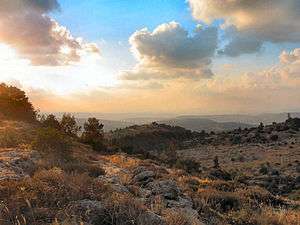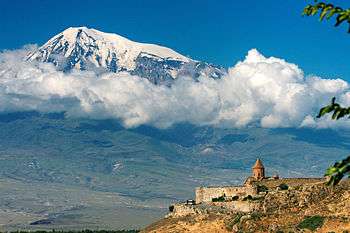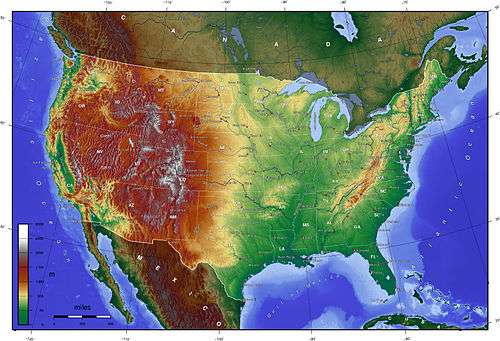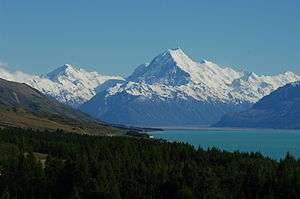Mountain ranges
Mountain ranges are regions of the earth with a high concentration of mountains.
Understand

A mountain range is an area of geologically-related mountains. They are typically created by plate tectonics (such as the Andes in South America) but can also be formed by other processes. The islands of Hawaii are actually the summits of an underwater mountain range formed by volcanoes.
Mountain ranges are good places to find the beginnings of rivers, particularly those that go a long way. For example, the Amazon River begins in the Andes Mountains in South America, and the Missouri River begins in the Rocky Mountains in North America. However, these sections of rivers are usually narrow, unlike the wide rivers you can find in flatter regions.
While mountain ranges are generally associated with being far above sea level, there are actually mountain ranges deep under the surface of the oceans. The best example is the Mid-Atlantic Ridge.
Prepare
See Mountaineering for advice around preparing for mountain climbing in general and Altitude sickness, Cold weather and Snow safety for some of the risks. The individual mountains vary in size and features, and treks can be chosen according to your level of fitness and experience.
Destinations
Africa
- The 🌍 Atlas Mountains are in Algeria, Morocco and Tunisia.
- 🌍 Eastern Rift Mountains
- The 🌍 Drakensberg, in South Africa
Antarctica
Asia
Western Asia

- The 🌍 Judaean Mountains are in Israel and the West Bank.
- The 🌍 Pontic Mountains (also known as the Pontic Alps) stretch along Turkey's Black Sea coast.
- The 🌍 Taurus, Anti-Taurus, and Eastern Taurus Mountains form a massive range extending from the Mediterranean coast of Turkey to the Iranian border. The Mount Nemrut is a famous summit in the eastern part of the range.
- The 🌍 Zagros Mountains are mostly found along Iran's western border, but also reach through Iraq.
Far East
- The 🌍 Baekdu Mountains are on the border between North Korea and China, and considered the origin of the Korean people. The Chinese part is known as Changbai.
- 🌍 Japan Alps
- The 🌍 Taebaek Mountains run down the east coast of the Korean peninsular.
Southern Asia
- The 🌍 Himalayan Mountains, probably best known for Mount Everest, are actually the southeastern fork of a large mountainous area in Central, South and East Asia comprising several mountain chains such as Karakoram, Pamir Mountains, Altai, Tian Shan, Hindu Kush and Kunlun. All the world's mountains above 7,000 m (23,000 ft) are in the Himalayas or one of the other mountain ranges listed in the previous sentence; however, the Himalayas contain the highest peaks of all, making them extremely famous; like the Sierra Nevada Mountains of California, one side (in the case of the Himalayas, the southern side) is wetter and is a longer increase in elevation, while the other side (the northern side) is dry.
- 🌍 Knuckles Mountain Range in Sri Lanka
Europe

- The 🌍 Alps both divide and connect the the European continent. They are perhaps the most "developed" mountain range in the world, particularly in terms of downhill snowsports. The Alps can be found in several European countries, but the countries they dominate most are the small nations of Switzerland and Austria.
- The 🌍 Apennines are in Italy.
- The 🌍 Balkan Mountains are in southern Europe.
- The 🌍 Rhodope Mountains strech along the Greek-Bulgarian border in southern Europe. It is a sparsely populated area rich in rare cultural sites of the ancient Thracians and with impressive areas of exceptional natural beauty
- The 🌍 Carpathian Mountains are in Central and Eastern Europe.
- The 🌍 Caucasus Ranges extend from west to east and are regarded as a geographical border between Europe and Asia.
- The 🌍 Dinaric Alps cover much of the western Balkans.
- The 🌍 Harz mountains were once divided by the Iron Curtain and are still in two separate Bundesländer. They are the northernmost mountain range in Germany.
- The 🌍 Pyrenees are a high mountain range — at least by European standards — shared by France, Spain and Andorra. Moreover, much of the Iberian peninsula is mountainous, made up of numerous smaller mountain ranges.
- The 🌍 cover most of Norway, a considerable part of northwestern Sweden and some of northern Finland.
- The 🌍 Scottish Highlands are found in the more remote parts of Scotland, at the northern end of the island of Great Britain.
- The 🌍 Urals are a Russian mountain range that are often regarded as the border between Europe and Asia.
North America
United States

- There is a long chain of 🌍 Appalachian Mountains in the eastern United States, extending into Québec as the Laurentian Mountains (see the Canada section below). They're not particularly high mountains, but they stand out because they are in a part of North America without many mountains. They are well-known for their autumn scenery; since the Appalachians are covered by deciduous forests, they have the fall colors not found in mountain ranges with evergreen forests. The Great Smoky Mountains National Park and the Appalachian Trail provide plenty of hiking options in the Appalachians.
- The 🌍 Alaska Range includes Denali (also known as Mount McKinley), the highest mountain in North America. Denali is a long way north, being west of Canada in the U.S. state of Alaska as the name of the mountain range implies.
- The 🌍 Black Hills are in the southwestern part of South Dakota.
- The 🌍 Cascade Mountains are in the western United States, not very far from the Pacific Coast. They are north of the Sierra Nevada Range and, for practical purposes are part of the same range. They are a good destination if you want to see volcanoes like Mount Rainier and Mount Lassen; however, these volcanoes are not safe, and Mount Saint Helens is a "good" example of a volcano in the range that erupted powerfully. Crater Lake is a popular destination in the Cascades.
- There are many Coastal Ranges in the western and southern portions of California. These mountain ranges are not particularly high, and not all of them are right on the coast; however, since in many places they extend right up to the coastline, the coastal views are very dramatic in many places.
- There are many mountain ranges in the Great Basin region of the Western United States. These mountain ranges more closely resemble the eastern side of the Sierra Mountains than the western side of that range. Great Basin National Park, the location of Wheeler Peak, is a U.S. National Park in the Great Basin.

- The 🌍 Ozarks is a hilly region in the Southern United States.
- The U.S. portion of the 🌍 Rocky Mountains is centered in the state of Colorado, west of the city of Denver.
- The 🌍 Sierra Nevada Range in California (often referred to as the "Sierras") includes the highest mountain peak in the contiguous United States, Mount Whitney. Unlike the Cascades to the north, the Sierras are free of volcanoes, and therefore you don't get individual, large mountains. The western side of the Sierras is a much more gradual slope than the eastern side; the eastern side marks the western end of the Great Basin. Popular destinations in the Sierras include Lake Tahoe and three national parks: Yosemite, Kings Canyon, and Sequoia.
Canada
- The 🌍 Canadian Rockies are the northward continuation of the Rocky Mountains into Canada. A popular destination in the Canadian Rockies is Banff National Park.
- The 🌍 Laurentians are an extension of the Appalachian range into Quebec. They include a number of popular ski resorts.
Oceania
Australia
- The 🌍 Great Dividing Range runs along the east coast of Australia, to which the Blue Mountains belong
- The 🌍 MacDonnell Ranges are in the centre of the Australian continent
New Zealand

- The 🌍 Southern Alps in the South Island of New Zealand.
- The 🌍 Central North Island has some mountains.
New Guinea
- The 🌍 New Guinea Highlands are on the island of New Guinea; the highlands are among the few places where glaciers can be found on the equator.
South America
- The 🌍 Andes Mountain Range includes Aconcagua, a mountain peak at nearly 7,000 m (23,000 ft) above sea level. Aconcagua is the highest mountain outside the Himalayas and mountain ranges near the Himalayas. The Andes Mountains extend north-south through all of the South American continent and they are, therefore, one of the largest mountain ranges (if not the largest) in the world in length and width. You can find Andes Mountains in most of the countries in South America, including Peru, Bolivia, Chile, and Argentina. In the far south of the mountain range is the Patagonia region.
See also
- Hiking in the United States
- Hiking in the Nordic countries
- Hiking destinations in Norway
- Mountaineering
- Seven Summits – Climb the highest mountain in each of the 7 continents
- Tramping in New Zealand
- Volcanoes